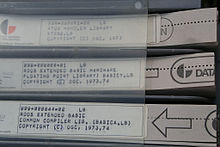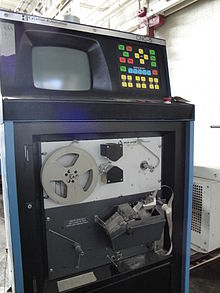- Punched tape
-
Punched tape or paper tape is an obsolete form of data storage, consisting of a long strip of paper in which holes are punched to store data. It was widely used during much of the twentieth century for teleprinter communication, for input to computers of the 1950s and 1960s, and later as a storage medium for minicomputers and CNC machine tools.
Contents
Origin
The earliest forms of punched tape come from weaving looms and embroidery, where cards with simple instructions about a machine's intended movements were first fed individually as instructions, then controlled by instruction cards, and later were fed as a string of connected cards. (See Jacquard loom).
This led to the concept of communicating data not as a stream of individual cards, but one "continuous card", or a tape. Many professional embroidery operations still refer to those individuals who create the designs and machine patterns as "punchers", even though punched cards and paper tape were eventually phased out, after many years of use, in the 1990s.
In 1846, Alexander Bain used punched tape to send telegrams.
Tape formats
Data was represented by the presence or absence of a hole in a particular location. Tapes originally had five rows of holes for data. Later tapes had 6, 7 and 8 rows. A row of narrower sprocket holes that were always punched served to feed the tape, typically with a wheel with radial teeth called a sprocket wheel. An early electro-mechanical calculating machine, the Automatic Sequence Controlled Calculator or Harvard Mark I, used paper tape with 24 rows.[1] Text was encoded in several ways. The earliest standard character encoding was Baudot, which dates back to the nineteenth century and had 5 holes. Later standards, such as Teletypesetter (TTS), Fieldata and Flexowriter, had 6 holes. In the early 1960s, the American Standards Association led a project to develop a universal code for data processing, which became known as ASCII. This 7-level code was adopted by some teleprinter users, including AT&T (Teletype). Others, such as Telex, stayed with Baudot.
Chadless Tape
Most tape-punching equipment used solid punches to create holes in the tape. This process inevitably creates "chad", or small circular pieces of paper. Managing the disposal of chad was an annoying and complex problem, as the tiny paper pieces had a distressing tendency to escape and interfere with the other electromechanical parts of the teleprinter equipment.
One variation on the tape punch was a device called a Chadless Printing Reperforator. This machine would punch a received teleprinter signal into tape and print the message on it at the same time, using a printing mechanism similar to that of an ordinary page printer. The tape punch, rather than punching out the usual round holes, would instead punch little U-shaped cuts in the paper, so that no chad would be produced; the "hole" was still filled with a little paper trap-door. By not fully punching out the hole, the printing on the paper remained intact and legible. This enabled operators to read the tape without having to decipher the holes, which would facilitate relaying the message on to another station in the network. Also, of course, there was no "chad box" to empty from time to time. A disadvantage to this mechanism was that chadless tape, once punched, did not roll up well, because the protruding flaps of paper would catch on the next layer of tape, so it could not be rolled up tightly. Another disadvantage, as seen over time, was that there was no reliable way to read chadless tape by optical means employed by later high-speed readers. However, the mechanical tape readers used in most standard-speed equipment had no problem with chadless tape, because it sensed the holes by means of blunt spring-loaded sensing pins, which easily pushed the paper flaps out of the way.
Applications
Communications
Punched tape was used as a way of storing messages for teletypewriters. Operators typed in the message to the paper tape, and then sent the message at the maximum line speed from the tape.
This permitted the operator to prepare the message "off-line" at the operator's best typing speed, and permitted the operator to correct any error prior to transmission. An experienced operator could prepare a message at 135WPM (Words Per Minute) or more for short periods.
The line typically operated at 75WPM, but it operated continuously. By preparing the tape "off-line" and then sending the message with a tape reader, the line could operate continuously rather than depending on continuous "on-line" typing by a single operator. Typically, a single 75WPM line supported three or more teletype operators working offline.
Tapes punched at the receiving end could be used to relay messages to another station. Large store and forward networks were developed using these techniques.
Paper tape could be read into computers at up to 1000 characters per second.[2]
Minicomputers
When the first minicomputers were being released, most manufacturers turned to the existing mass-produced ASCII teleprinters (primarily the ASR33 capable of 10 ASCII characters per second throughput) as a low-cost solution for keyboard input and printer output. The commonly specified Model 33 ASR included a paper tape punch/reader, where ASR stands for "Automatic Send/Receive" as opposed to the punchless/readerless KSR - Keyboard Send/Receive and ROP - Receive Only Printer models. As a side effect, punched tape became a popular medium for low cost minicomputer data and program storage, and it was common to find a selection of tapes containing useful programs in most minicomputer installations. Faster optical readers were also common.
Binary data transfer to or from these minicomputers was often accomplished using a doubly encoded technique to compensate for the relatively high error rate of punches / readers. The low-level encoding was typically ASCII, further encoded and framed in various schemes such as Intel Hex - in which a binary value of "01011010" would be represented by the ASCII characters "5A". Framing, addressing and checksum (primarily in ASCII hex characters) information provided error detection capabilities. Efficiencies of such an encoding scheme are on the order of 35-40% (e.g., 36% from 44 8-bit ASCII characters being needed to represent 16 bytes of binary data per frame).
Data transfer for ROM and EPROM programming
In the 1970s through the early 1980s, paper tape was commonly used to transfer binary data for incorporation in either mask-programmable read-only memory (ROM) chips or their erasable counterparts - EPROMs.
A significant variety of encoding formats were developed for use in computer and ROM/EPROM data transfer.[3] Encoding formats commonly used were primarily driven by those formats that EPROM programming devices supported and included various ASCII hex variants as well as a number of computer-proprietary formats.
A much more primitive as well as a much longer high-level encoding scheme was also used - BNPF (Begin-Negative-Positive-Finish). In BNPF encoding, a single byte (8 bits) would be represented by a highly redundant character framing sequence starting with a single ASCII "B", eight ASCII characters where a "0" would be represented by a "N" and a "1" would be represented by a "P", followed by a ending ASCII "F". These ten-character ASCII sequences were separated by one or more whitespace characters, therefore using at least 11 ASCII characters for each byte stored (9% efficiency). The ASCII "N" and "P" characters differ in four bit positions, providing excellent protection from single punch errors. Alternative schemes were also available where "H" and "L" or "0" and "1" were also available to represent data bits, but in both of these encoding schemes, the two data-bearing ASCII characters differ in only one bit position, providing very poor single punch error detection.
Cash registers
National Cash Register or NCR (Dayton Ohio) made cash registers around 1970 that would punch paper tape. The tape could then be read into a computer and not only could sales information be summarized, billings could be done on charge transactions.
Newspaper industry
Punched paper tape was used by the newspaper industry until the mid-1970's or later. Newspapers were typically set in hot lead by devices such as a linotype. With the wire services coming into a device that would punch paper tape, rather than the linotype operator having to retype all the incoming wire stories, the paper tape could be put into a paper tape reader on the linotype and it would create the lead slugs without the operator re-typing the stories. This also allowed newspapers to use devices, such as the Friden Flexowriter, to convert typing to lead type via tape. Even after the demise of the Linotype/hot lead, many early "offset" devices had paper tape readers on them to produce the news-story copy.
Automated machinery
In the 1970s, computer-aided manufacturing equipment often used paper tape. Paper tape was a very important storage medium for computer-controlled wire-wrap machines, for example. A paper tape reader was smaller and much less expensive than hollerith card or magnetic tape readers. Premium black waxed and lubricated long-fiber papers, and Mylar film tape were invented so that production tapes for these machines would last longer.
Cryptography
Paper tape was the basis of the Vernam cipher, invented in 1917. During the last third of the 20th century, the U.S. National Security Agency used punched paper tape to distribute cryptographic keys. The 8-level paper tapes were distributed under strict accounting controls and were read by a fill device, such as the hand held KOI-18, that was temporarily connected to each security device that needed new keys. NSA has been trying to replace this method with a more secure electronic key management system (EKMS), but paper tape is apparently still being employed.
Limitations
The three biggest problems with paper tape were:
- Reliability. It was common practice to follow each mechanical copying of a tape with a manual hole by hole comparison.
- Rewinding the tape was difficult and prone to problems. Great care was needed to avoid tearing the tape. Some systems used fanfold paper tape rather than rolled paper tape. In these systems, no rewinding was necessary nor were any fancy supply reel, takeup reel, or tension arm mechanisms required; the tape merely fed from the supply tank through the reader to the takeup tank, refolding itself back into exactly the same form as when it was fed into the reader.
- Low information density. Datasets much larger than a few dozen kilobytes are impractical to handle in paper tape format.
Advantages
Punched tape does have some useful properties:
- Longevity. Although many magnetic tapes have deteriorated over time to the point that the data on them has been irretrievably lost, punched tape can be read many decades later, if acid-free paper or Mylar film is used. Some paper can degrade rapidly.
- Human accessibility. The hole patterns can be decoded visually if necessary, and torn tape can be repaired (using special all-hole pattern tape splices). Editing text on a punched tape was achieved by literally cutting and pasting the tape with scissors, glue, or by taping over a section to cover all holes and making new holes using a manual hole punch.
- Magnetic field immunity. In a machine shop full of powerful electric motors, the numerical control programs need to survive the magnetic fields generated by those motors.[4][5]
- Ease of destruction. In the case of cryptographic keys, the inherent flammability (sometimes enhanced by using flash paper) of paper tape was an asset. Once the key was loaded into the device, or if it may fall into enemy hands, the paper tape was simply burned.
Punched tape in art
A computing or telecommunications professional depicted in the Monument to the Conquerors of Space in Moscow (1964) holds what appears to be a punched tape with three rows of rectangular holes.
Current use
Use of punched tape today is rare to nonexistent. No systems built new today still use punched paper tape. In CNC machining applications, what few existing installations remained in grandfathered use are now quickly disappearing as the temporary advantages for new orders of old part designs (i.e., not rewriting programs or retooling machines) are being washed away by natural economic evolution (fewer such orders as decades go by; part design revisions required reprogramming anyway; newer, higher-capability machines now successfully poaching the orders; etc.).
See also
- Bit bucket
- Book music
- Chad (the little pieces of paper punched out of the tape).
- Jacquard loom Controlled by a system similar to, but not quite the same as punched tape.
- Key punch
- Music roll
- Piano roll
- Punched card
- Zygalski sheets - a system used to decrypt messages enciphered on German Enigma machines.
References
- ^ Dalakov, Georgi, History of computers: The MARK computers of Howard Aiken, http://history-computer.com/ModernComputer/Relays/Aiken.html, retrieved 2011-01-12
- ^ Hult, Ture (1963), "Presentation of a new high speed paper tape reader", BIT Numerical Mathematics 3 (2): 93–96, doi:10.1007/BF01935575
- ^ "Translation File Formats". Data I/O Corporation. ftp://ftp.data-io.com/main/Manuals/UniFam/Translation%20Formats.pdf. Retrieved 2010-08-30.
- ^ Microprocessor-based Control Systems by Naresh Kumar Sinha Page 264: "Paper tape is well suited to a machine shop environment whereas magnetic tape may be accidentally erased or contaminated by foreign substances. ... Other disadvantages of paper tape are as follows ..."
- ^ "computer programming punch paper tape": "Factory computer numerical control (CNC) equipment used paper tape well into the 1980s"
External links
- ECMA-10: ECMA standard for Data Interchange on Punched Tape
- A song mentioning paper tape
- Various punched media
- Friden Flexowriter combination typewriter, paper tape punch, and paper tape reader, designed by IBM during the 1940s and bought out by Friden in the late 1950s (Retrieved April 10, 2007)
- Olympia Flexowriter
- Detailed description of two paper tape code systems, Baudot code and the system used by the ILLIAC computer
Punched tape (1846) · Book music (1863) · Ticker tape (1867) · Piano roll (1880s) · Punched card (1890) · Edge-notched card (1896) · Optical mark recognition · Optical character recognition (1929) · Barcode (1948) · Paper disc (2004)
Categories:- Computer storage tape media
Wikimedia Foundation. 2010.







